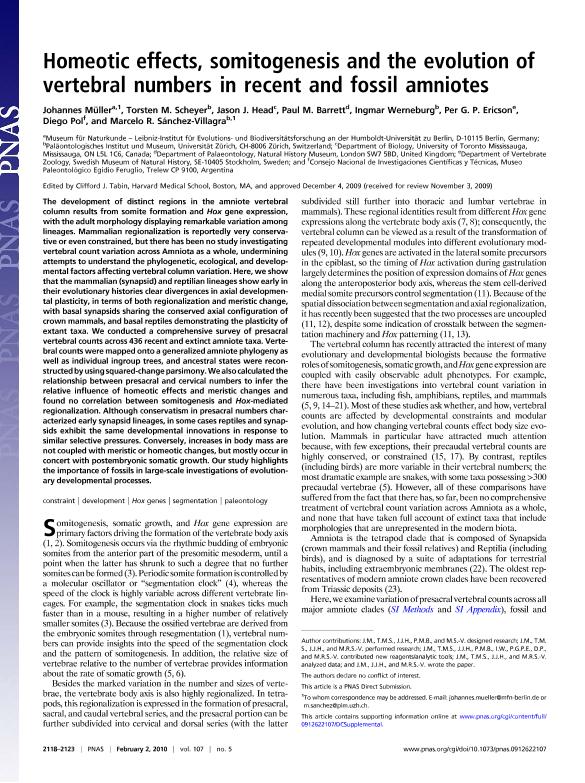Artículo
Homeotic effects, somitogenesis and the evolution of vertebral numbers in recent and fossil amniotes
Müllera, Johannes; Scheyer, Torsten M.; Head, Jason J.; Barrett, Paul M.; Werneburg, Ingmar; Ericson, Per G. P.; Pol, Diego ; Sánchez Villagra, Marcelo R.
; Sánchez Villagra, Marcelo R.
 ; Sánchez Villagra, Marcelo R.
; Sánchez Villagra, Marcelo R.
Fecha de publicación:
02/2010
Editorial:
National Academy of Sciences
Revista:
Proceedings of the National Academy of Sciences of The United States of America
ISSN:
0027-8424
Idioma:
Inglés
Tipo de recurso:
Artículo publicado
Clasificación temática:
Resumen
The development of distinct regions in the amniote vertebral column results from somite formation and Hox gene expression, with the adult morphology displaying remarkable variation among lineages. Mammalian regionalization is reportedly very conservative or even constrained, but there has been no study investigating vertebral count variation across Amniota as a whole, undermining attempts to understand the phylogenetic, ecological, and developmental factors affecting vertebral column variation. Here, we show that the mammalian (synapsid) and reptilian lineages show early in their evolutionary histories clear divergences in axial developmental plasticity, in terms of both regionalization and meristic change, with basal synapsids sharing the conserved axial configuration of crown mammals, and basal reptiles demonstrating the plasticity of extant taxa. We conducted a comprehensive survey of presacral vertebral counts across 436 recent and extinct amniote taxa. Vertebral counts were mapped onto a generalized amniote phylogeny as well as individual ingroup trees, and ancestral states were reconstructed by using squared-changeparsimony. We also calculated the relationship between presacral and cervical numbers to infer the relative influence of homeotic effects and meristic changes and found no correlation between somitogenesis and Hox-mediated regionalization. Although conservatism in presacral numbers characterized early synapsid lineages, in some cases reptiles and synapsids exhibit the same developmental innovations in response to similar selective pressures. Conversely, increases in body mass are not coupled with meristic or homeotic changes, but mostly occur in concert with postembryonic somatic growth. Our study highlights the importance of fossils in large-scale investigations of evolutionary developmental processes.
Palabras clave:
Constraint
,
Development
,
Hox Genes
,
Paleontology
,
Segmentation
Archivos asociados
Licencia
Identificadores
Colecciones
Articulos(SEDE CENTRAL)
Articulos de SEDE CENTRAL
Articulos de SEDE CENTRAL
Citación
Müllera, Johannes; Scheyer, Torsten M.; Head, Jason J.; Barrett, Paul M.; Werneburg, Ingmar; et al.; Homeotic effects, somitogenesis and the evolution of vertebral numbers in recent and fossil amniotes; National Academy of Sciences; Proceedings of the National Academy of Sciences of The United States of America; 107; 5; 2-2010; 2118-2123
Compartir
Altmétricas



